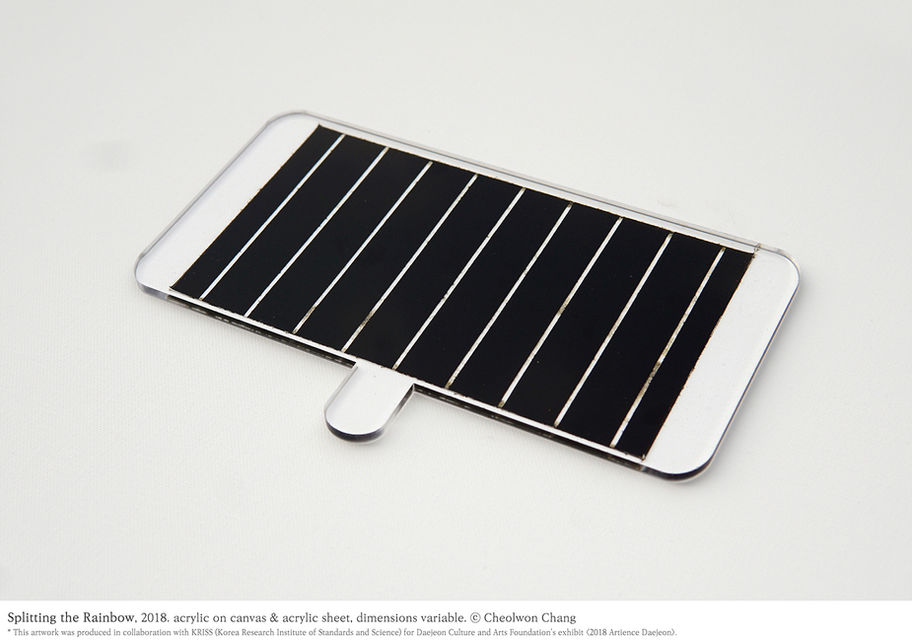Splitting the Rainbow
Featuring 12 repeating colors painted vertically on the canvas, this painting is reminiscent of a rainbow. Chang asks the viewers to see his rainbow-colored painting through a smartphone-shaped acrylic sheet placed in front of the painting. Seen through this simple device which uses only one eye, the rainbow is transformed into single colors such as red, yellow and green. Colors of the rainbow are in themselves analytic, but the intervention of another device reverts them to purer colors. The colors reflected by the painting look different depending on the photon’s energy, calculated by multiplying the light's frequency with the Planck constant (hv). Titled ‘Splitting the Rainbow,’ this painting presents an artistic method through which the viewer distinguishes and separates certain colors from the numerous lights that blend around us.
Sestina
[Sestina] is a piece presenting Pi (3.14159...), an irregular, infinite decimal, inflected by Sestina, a series of mathematical rules. By designating a unique color on an invisible number (for example, 1 is orange, 5 is emerald), he transforms the number into a visible image. We are living in an umpredictable world. However, at the same time, we can make a prediction 'to a certain degree.' By showing this though the symbolic structure of number, he seeks to represent the world on a smaller scale. There are 2016 squares per image, and each square is hand-painted.
Ratio
Chang converted 4,897 numbers in the decimals of √2 to colors and latch hooked them into a rug. 12th-century troubadour Arnaut Daniel wrote sestinas which were governed by a particular mathematic rule, and Chang took this rule to arrange each color. The non-repetitive decimal’s irregularity collapses as it confronts the strict regularity of Daniel’s sestina. To transcend the rigid and stern approach of filling numbers (colors) according to a predetermined pattern, Chang used a warm and cozy textile to realize a friendly and common yet complex image.
Ten Colors
Color stripes fill up a rectangular paper with width and length having a 1:1.414 ratio. The paper’s ratio, according to the Pythagorean theorem, is equal to the ratio of a square's side length to its diagonal. This is in fact is the ratio of an A4 paper’s width and length, the most familiar paper size to the majority of the world. This frame is divided into six spaces akin to strata. The spaces are filled with stripes of lines; the colors assigned to each number, representing the decimal digits of the infinite sequence of 1.414... Due to the nature of this number, the colors are randomly arranged. In other words, although the frame of this image is ordered, the content is purely chaotic. Chang explained, ‘For me the act of artmaking is the act of materializing such invisible phenomena, and in the process, I experience the asceticism of a repetitive yet non-repetitive process.’
Stars from the CMY
By employing colors and shapes printed on many layers of transparent sheets, [Stars from the CMY] expanded light’s capacity to intervene. Depending on the position of the viewer’s eyes, color or light are blended in real-time. Chang covered his picture frame with a photorefractive film in a way which combines color and shapes. Thereby the images on either side become merged when the artwork is viewed directly from the front. Chang explained that, while printed ink is based on the principle of subtractive color mixing, the introduction of this transparent device resulted in additive color mixing which is akin to that of light.

























